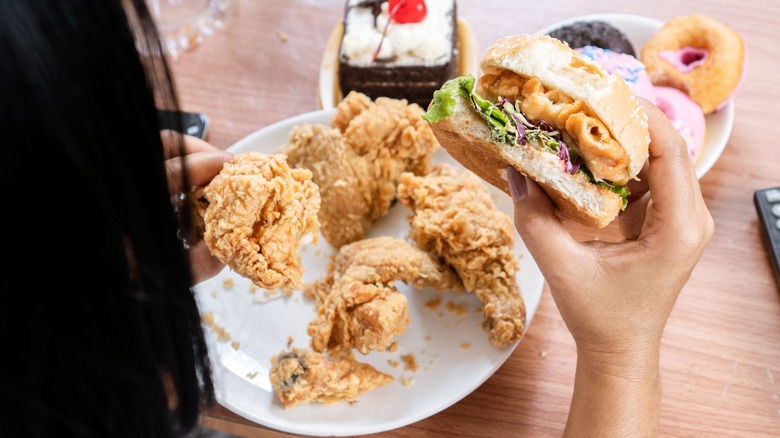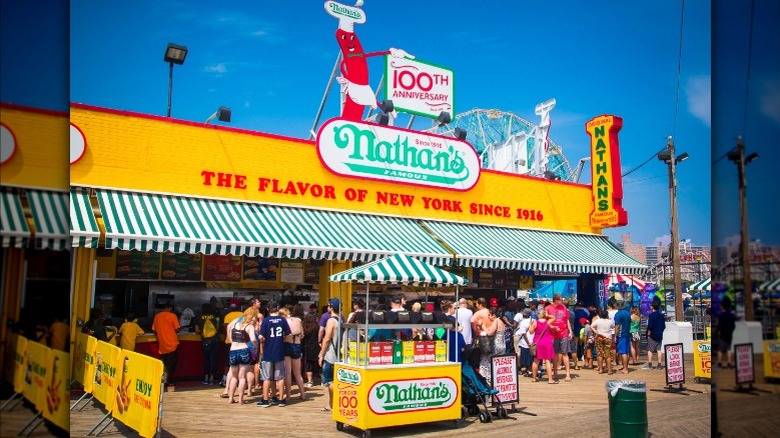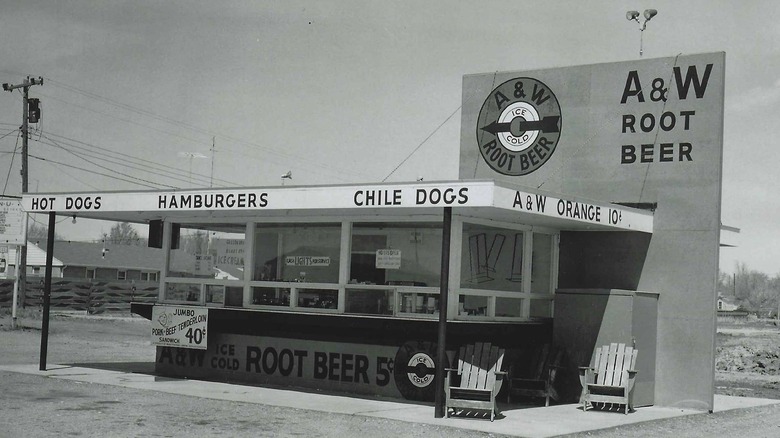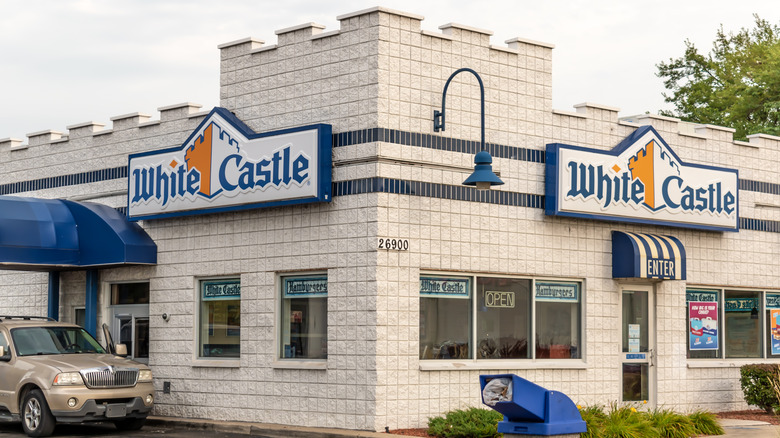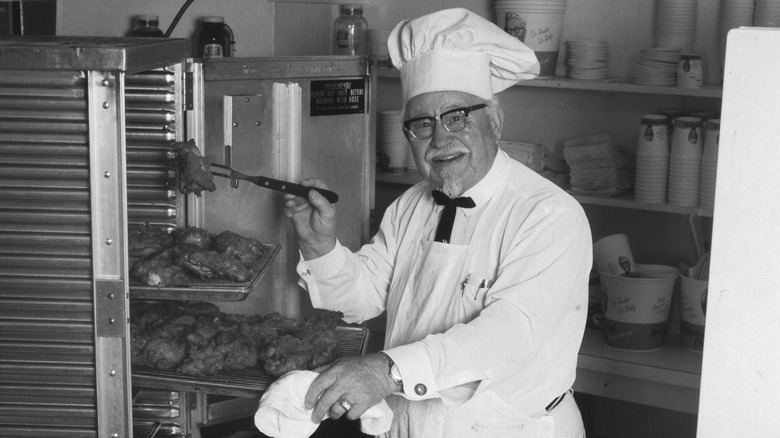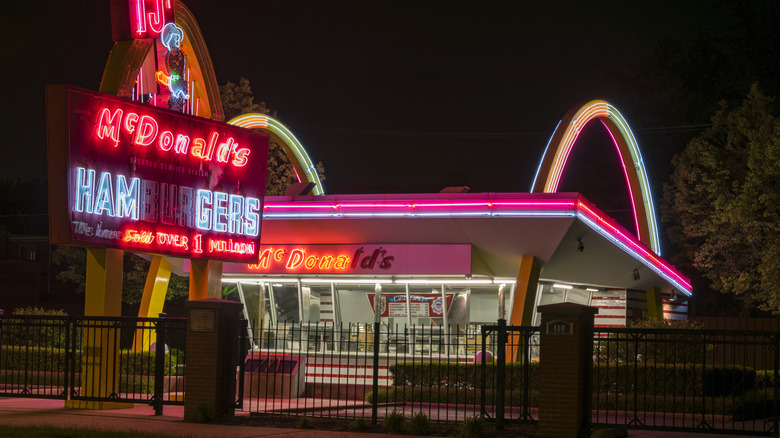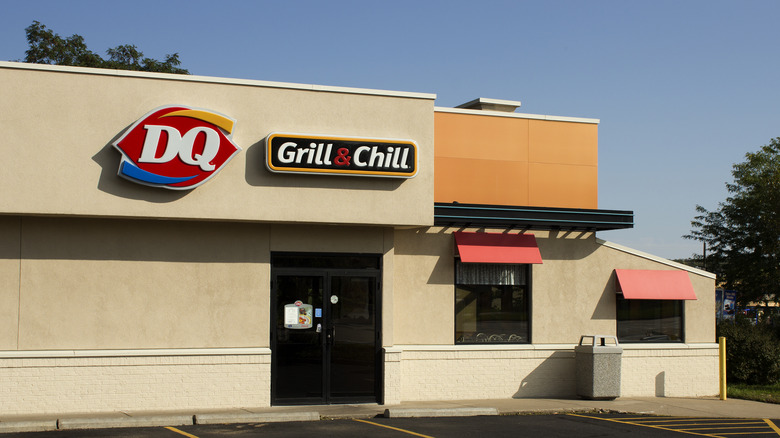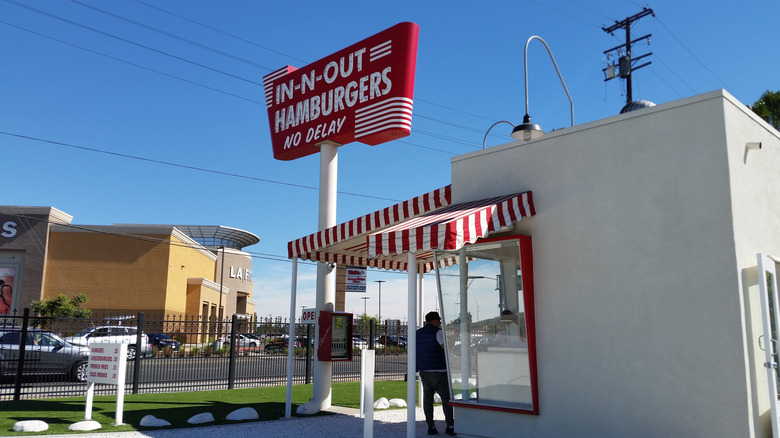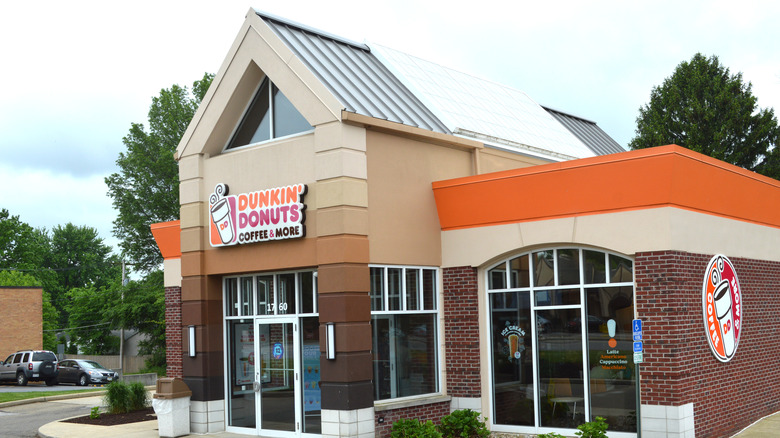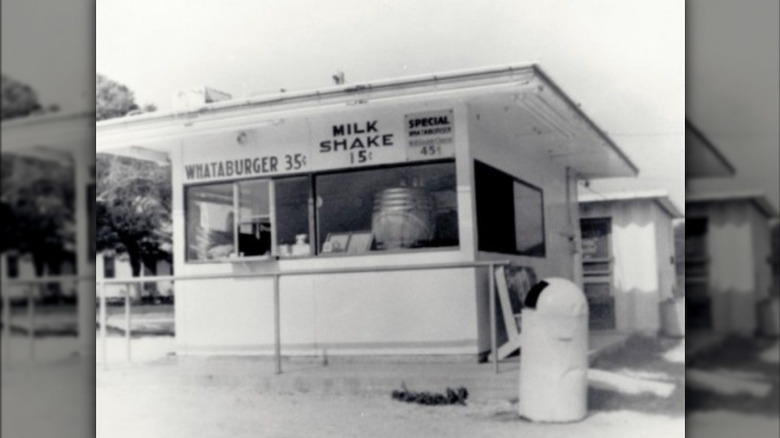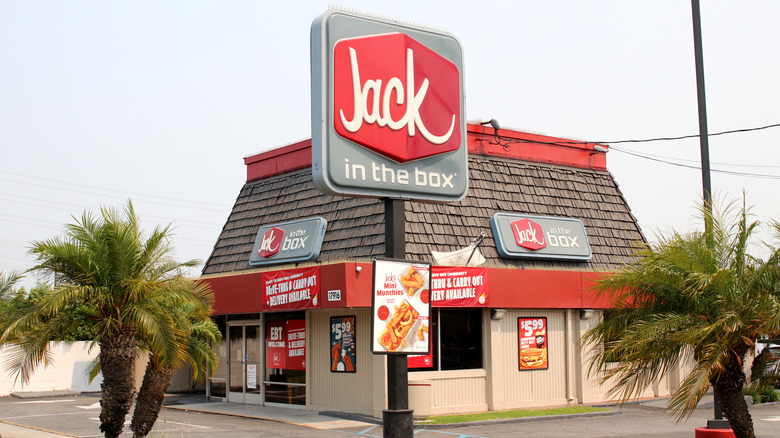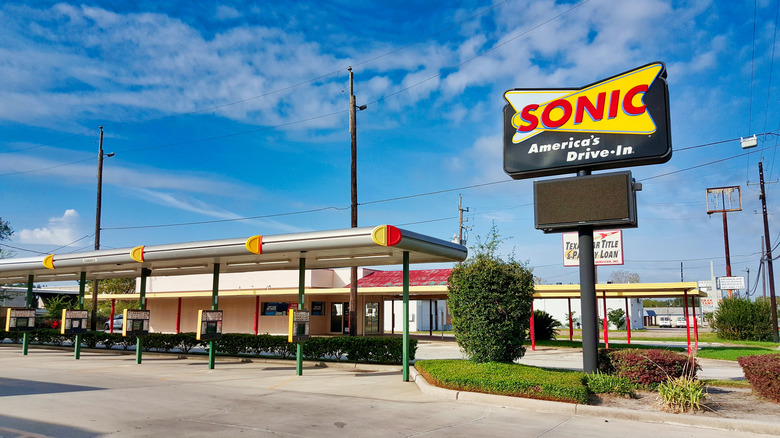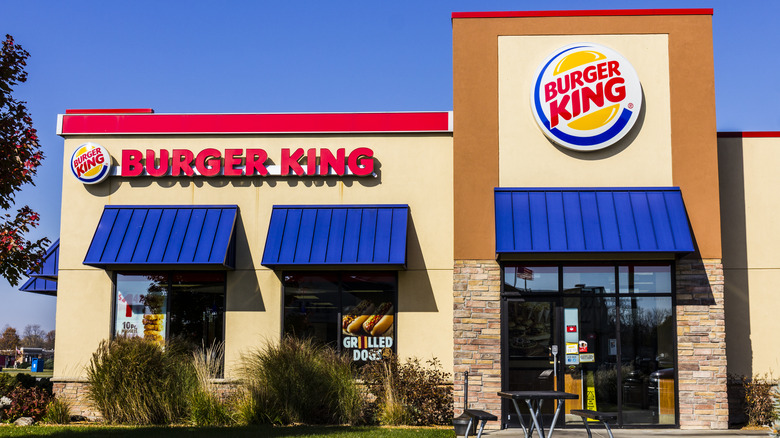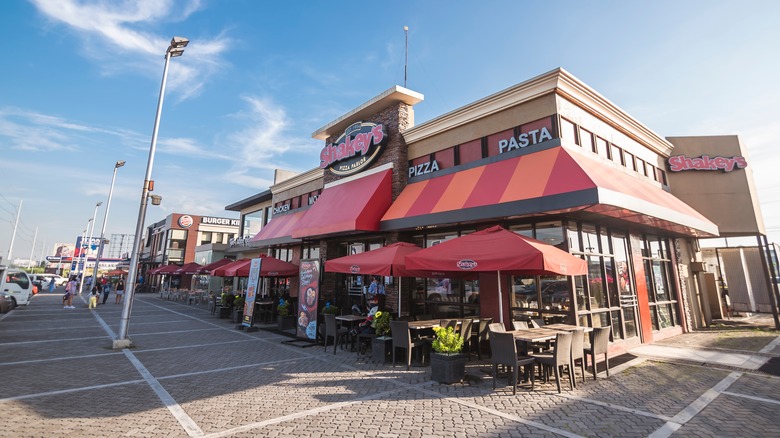Fast Food Chains That Are Older Than You Realize
There's no denying it — Americans love fast food. According to the Barbecue Lab, the average American consumes fast food between one and three times each week. With such staggering numbers, it's not surprising that fast food has become an integral part of the American psyche. With chains such as McDonald's and KFC serving quick, convenient, and affordable fare, fast food restaurants offer both familiarity and a sense of comfort. After all, in a world where everything can change in a blink of an eye, there's much to be said for consistency and knowing that your favorite meal will be exactly the same as you remember it.
While this may be hard to fathom, fast food restaurants weren't always there to satisfy cravings. In fact, restaurant chains as we know them today didn't exist until the early 20th century. Nevertheless, some of the fast food joints that have survived and are still in existence have a surprisingly long history. Fast food chains didn't become popular in the U.S. until the 1950s and the1960s, as Adam Chandler explains in his book "Drive-Thru Dreams" (via Smithsonian Magazine). According to Chandler, the success of fast food in America can be attributed to the on-the-go lifestyle that emerged after the development of the highway system in the country.
Ready to find out about the world's oldest operating fast food chains? Keep reading.
Nathan's Famous (1916)
Nathan's Famous opened up for business on Coney Island way back in 1916. And the iconic original restaurant is still in the same location, right where a Polish immigrant Nathan Handwerker started his hot dog venture with $300 he borrowed from a friend. Nathan's strategy for business success was offering 5-cent hot dogs and it worked. "Once the Depression rolled around, that's when the business started taking off because you could feed a family of four for under 50 cents," Nathan's grandson Lloyd Handwerker told CBS News.
Today, Nathan's Famous has outlets around the globe, including in such far-flung destinations as Australia, Mexico, Malaysia, and the Philippines. The franchise has also revamped its menu and, alongside a range of all-beef hotdogs, specializes in burgers, sandwiches, fries, and premium shakes.
Every year on the 4th of July, the chain holds the Nathan's Famous Hot Dog Eating Contest, which brings together around 35,000 fast food enthusiasts to see who can eat the most hot dogs in 10 minutes. As it stands, the men's record is currently held by Joey Chestnut who managed to devour 76 hot dogs in the allotted time. The women's record-holder is Miki Sudo who ate her way to victory by consuming 48.5 hot dogs in the same time frame.
A&W (1919)
When Roy W. Allen rolled out his root beer stand in Lodi, California, in 2019, little did he know that over a century later his creation would be operating as A&W with close to 1,000 outlets across the world. It wasn't long before Allen's root beer became a local favorite. In 1922, Allen joined forces with Frank Wright, combining their last initials to form the A&W brand name. Together, they began franchising A&W root beer stands, becoming pioneers of the business model in the U.S. The venture boomed, and by 1950, the franchise had expanded to 450 outlets.
The A&W business really started thriving during Prohibition after the temperance movement caused a boom in soda's popularity. In 1963, the franchise started selling bacon cheeseburgers (it claims to have invented them). Now the chain sells a variety of fast food grub such as burgers, fries, coney dogs, and chicken meals.
Over 100 years after Allan first purchased his root beer recipe, A&W still makes its own root beer on a daily basis. After a switch to concentrate in 2000, the company reverted back to making its root beer on premises in 2017 in a move to return to the company's roots.
White Castle (1921)
Famous for its small square-shaped burgers known as sliders, White Castle has become an important part of America's fast food culture. And since its founding in 1921 as a family-owned business, the chain has grown in both size and popularity, today boasting over 300 locations across the U.S. And while White Castle may have streamlined its production process, today the fast food restaurant still sells similar sliders to those it offered to its customers for 5 cents a pop so many years ago. Luckily for us, the chain's menu has also expanded to include a range of sides, from shrimp nibblers to loaded fries.
Often referred to as the world's first hamburger chain, White Castle is also credited with pioneering the concept of carry-out food in 1927. According to the White Castle website, the fast food restaurant was also the first such business to use newspaper coupons. In 1933, the chain had a promo deal that offered five hamburgers for just 10 cents. By 1961, White Castle had sold one billion burgers, and in 1996, the chain launched the first ever fast food restaurant website. Today, White Castle is still innovating. In 2022, the franchise announced that it would be installing Flippy 2 — a robot engineered to deal with repetitive tasks such as frying french fries — in 100 of its outlets.
KFC (1930)
KFC's story begins with its founder, Colonel Harland Sanders. Born in 1890, Sanders faced numerous setbacks throughout his life, including a difficult childhood and financial struggles. After trying numerous jobs, in 1930 Sanders invested in a roadside motel in Corbin, Kentucky, where he started serving food.
One of the favorites on Sanders' menu was his Southern-style fried chicken. And since the item took around 30 minutes to cook (way too long considering the demand), Sanders came up with the idea of frying the chicken in a pressure cooker, cutting the preparation time to around 8 minutes. In 1939, the entrepreneur invented his famous secret recipe that blends 11 herbs and spices. "I threw two handfuls of it into the flour and stirred it up with the rest of my seasonings. When I fried it up, it was the best chicken I'd ever tasted in my life," Sanders wrote in his autobiography.
Sanders' entrepreneurial and culinary efforts didn't go unnoticed. By 1936, Sanders was awarded the prestigious title of Colonel by the governor of Kentucky. Forever a businessman, Sanders first franchised his secret recipe in 1952 to a Kentucky Fried Chicken near Salt Lake City in Utah. By 1963, there were over 600 Kentucky Fried Chicken locations in both the U.S. and Canada. A year later, in 1964, Sanders sold his beloved business to a group of investors for a cool $2 million, with one of the conditions being that he remained the public face of the venture.
McDonald's (1940)
With around 38,000 outlets in more than 100 countries, McDonald's is the biggest fast food retailer in the world. But things weren't always so grandiose for the fast food giant. Founded by two siblings Richard and Maurice McDonald in 1940, McDonald's started out as a small barbecue stand in San Bernardino, California. The restaurant was a success, leading the brothers to limit their menu to the most popular items, including 15-cent hamburgers. The duo also streamlined their service to deliver food quickly and efficiently using an assembly-line system.
While McDonald's sold its first franchise in 1954, things didn't really take off in a big way until Ray Kroc purchased the company in 1961. Forking out $2.7 million, Kroc revolutionized the business, setting a precedent for huge growth. The same year, Kroc also founded Hamburger University to train future franchisees. Shortly after, McDonald's debuted its two advertising powerhouses — the golden arches logo and the Ronald McDonald mascot. The business grew from strength to strength in the coming years, and in 1984 one of its original founders, Richard, was presented with the chain's 50 billionth hamburger.
Dairy Queen (1940)
The story of Dairy Queen's success began in 1938, two years prior to its opening, when John Fremont McCullough and his son Alex McCullough came up with what today is known as Dairy Queen soft serve. The duo then combined forces with their friend Sherb Noble who agreed to sell the product as a part of an "All You Can Eat" deal at his store in Kankakee, Illinois. Noble ended up serving over 1,600 orders of soft serve in just two hours. In 1939, the business partners got hold of a freezer that could dispense a soft flow of ice cream, and the rest is history.
When Dairy Queen first opened its doors in Joliet, Illinois, in 1940, soft serve ice cream was still a novelty. Nevertheless, the cool treat quickly became a hit with consumers, who enjoyed its smooth and creamy texture. In fact, the store did so well that by 1950 the number of Dairy Queen locations increased to 3,000. Three years later, in 1953, the first Dairy Queen opened outside the U.S. in Winnipeg, Canada. Over the years, the chain's menu expanded to include burgers, french fries, and hot dogs. Standing testament to its popularity today the popular franchise boasts more than 7,000 locations around the globe.
In-N-Out Burger (1948)
What set the first In-N-Out Burger stand apart from other fast food outlets when it opened in 1948 was its drive-through. The 10-square-foot space in Baldwin Park, Los Angeles, also featured a two-way speaker, which was used by customers to order their hamburgers. Up to this time, fast food outlets used carhops to deliver food to patrons who didn't feel like leaving their cars.
In-N-Out Burger was founded by a husband and wife team, Harry and Esther Snyder. Initially, it was Harry who frequented the markets each morning to select the freshest produce for the day while Esther took the role of the venture's accountant. The restaurant's original menu was fairly limited, with the famous Animal Style burger only making an appearance in 1961 and the Double-Double in 1963.
Since both Harry and Esther valued quality above profits, they didn't open another In-N-Out Burger outlet until 1951. Despite their success, the duo only opened 18 restaurants in the following 28 years. After Harry succumbed to lung cancer in 1976, his son Rich took over the business. During the '80s and '90s, under his watchful eye, the chain opened over 90 new outlets. Today, there are close to 400 In-N-Out Burger restaurants across the U.S., over half of which are located in California.
Dunkin' Donuts (1950)
The first-ever Dunkin' Donuts outlet in Quincy, Massachusetts, is still open for business. The store, which started out as Open Kettle in 1948, before changing its name to Dunkin' Donuts in 1950, has been refurbished to its original retro appearance. It's said that the chain's founder William Rosenberg decided on the new name after observing that many of the restaurant's patrons would dunk their donuts in the store's coffee.
The Dunkin' Donuts franchise was born just five years later, with the opening of a restaurant in Worcester. From then on, things progressed quickly. Before the end of 1963, the chain boasted 100 locations and by 1979 this number stood at 1,000. Over the years, Dunkin' Donuts also made new additions to its menu, including its signature Munchkins donut holes, as well as a variety of breakfast and sandwich items.
Today, Dunkin' Donuts has over 11,000 locations in 36 countries. And this isn't the chain's only impressive number. The franchise serves more than 50 types of donuts to over 3 million people each day.
Whataburger (1950)
Opening in 1950, the first Whataburger was a small roadside burger stand in Corpus Christi, Texas. The burger joint was founded by Harmon Dobson, who set out to make burgers that would make his customers shout "What a burger!" when they tasted the snack — hence, the chain's name. And apparently, he succeeded, which may be due to the fact that his burgers paired a quarter pound of beef with a 5-inch bun, making them substantially larger than the average two ounces of beef on a 2½-inch bun offered at the time.
On its opening day, the restaurant sold its burgers for 25 cents a piece, generating $50. Four days later, these numbers were substantially higher, with the store selling 551 burgers. Even though things were looking good for the business, Dobson had to increase the price of his burgers the following year, explaining on a sign, "Folks, we priced our burgers too low and we lost our shirts. Sorry, but we gotta raise the price to 30 cents."
In 1953, the first Whataburger franchise opened in Alice, Texas. By 1963, there were 26 Whataburger restaurants in Texas, Florida, Arizona, and Tennessee. At this stage, the chain's distinctive orange and white A-frame design was already a thing, since it had been introduced by Dobson in 1961. Unfortunately, Dobson, who was a pilot, died in a plane crash in 1967, never knowing how vast his empire would one day become. Today, Whataburger's 900-plus outlets generate $3 billion annually.
Jack in the Box (1951)
Jack in the Box wasn't always popular for its tacos, breakfast combos, and salads. When it was first founded in San Diego, California, in 1951, the fast food chain specialized in burgers, which were sold at the small roadside outlet at 18 cents a pop. Opened by Robert Oscar Peterson, the first Jack in Box location came complete with a drive-through service and an intercom system. A giant clown perched on the building's rooftop — later to become the chain's trademark symbol — enticed motorists to stop at the fast food joint. And the convenience offered by the outlet paid off. In 1956, there were 180 company-owned Jack in the Box locations.
In 1968, Jack in the Box was purchased by the Ralston Purina Company, which turned the venture into a franchise. While up to now, Jack in the Box targeted families, this changed in the 1980s, when the chain started advertising its products to a more affluent patron base. It was also around this time that the chain's mascot clown disappeared and its outlets were revamped to appeal to a new more professional clientele. Today, Jack in the Box serves more than 500 million customers each year at more than 2,200 locations and is still known for its drive-through service, with 90% of customers electing to use the service.
Sonic (1953)
Opening as Top Hat Drive-In in Shawnee, Oklahoma, in 1953, Sonic didn't get its current name until 1959. The four Top Hat Drive-Ins that opened between 1953 and 1959 had to be renamed when their founders Troy Smith and Charlie Pappe discovered that the name was already legally protected by copyright. The duo renamed the restaurant chain Sonic, drawing inspiration from its slogan, "Service with the Speed of Sound."
Right from the outset, Sonic relied on a speaker system and an army of carhops on roller skates to serve burgers, fries, and drinks directly to patrons seated in their cars. And this drive-in model is still in existence today, allowing customers to relive a bygone era while they indulge in a quick bite. The fast food chain even hosts an annual skating competition where its employees can showcase their skills and win prizes.
By the time Pappe passed away in 1967, the franchise boasted 41 outlets. Six years later, in 1973, this number grew to 124 locations across Oklahoma, Kansas, Texas, and Arkansas. Today, there are around 3,500 Sonic Drive-Ins across the U.S.
Burger King (1954)
Burger King's fast food journey started in 1954 when two entrepreneurs by the names of James W. McLamore and David Edgerton purchased an Insta-Burger King franchise in Miami. The chain's signature item, the Whopper, was born three years later in 1957.
The partners eventually ended up taking over the entire Insta-Burger King franchise in 1959 after the business experienced financial problems. And they managed to turn the company's luck around, replacing the Insta-Broiler originally used by the restaurants with a gas grill and shortening the chain's name to Burger King.
McLamore and Edgerton sold Burger King to the Pillsbury Company for $18 million in 1967. Burger King thrived under the new management, becoming the second-biggest burger franchise in the U.S. by the end of the 70s. Over the years, Burger King has changed hands numerous times, experiencing its fair share of peaks and troughs. Nevertheless, the chain remains a success, with around 20,000 locations worldwide that serve 11 million customers each day.
Shakey's Pizza (1954)
Shakey's Pizza may not be as popular as Pizza Hut or Domino's, but it was on the scene a few years before both of those chains even existed. Opened in 1954 as a spot to enjoy pizza, beer, and ragtime music in Sacramento, California, Shakey's Pizza and Ye Public House was all about enjoying quality live music and a casual meal. One of the restaurant's founders — Sherwood "Shakey" Johnson — was an avid fan of Dixieland jazz and he filled the restaurant with the sounds of player pianos and banjos. Today, a reproduction of the interior of the first Shakey's restaurant can still be found in the American Banjo Museum's Hall of Fame.
The good times continued and in 1956 Shakey's brought its music, thin-crust pizzas, fried chicken, and mojo potatoes to Portland, with the opening of the restaurant's second store. By 1967, the chain had over 272 outlets, even expanding to far-flung countries such as Japan and the Philippines in the following years. The old-school charm wasn't enough to keep the number of Shakey's restaurants growing in America, however. Notably, today Shakey's is doing better in the Philippines than it does in the U.S., with approximately 50 outlets in the U.S. and 300 in the Philippines.
